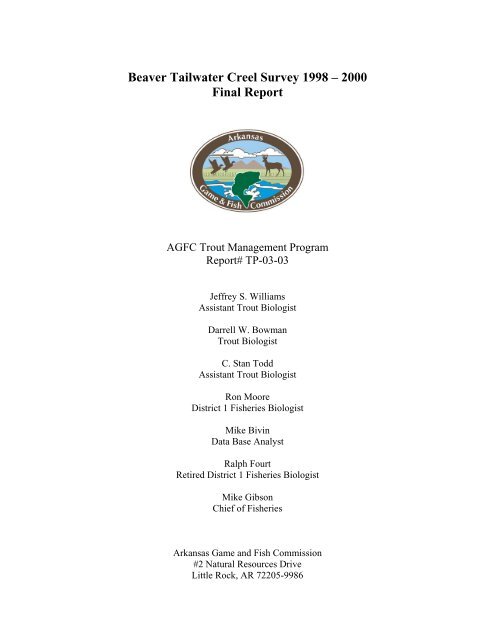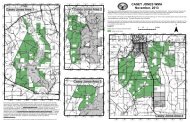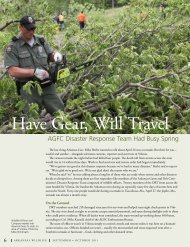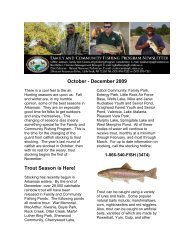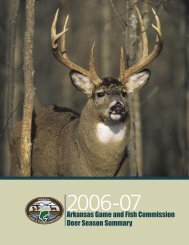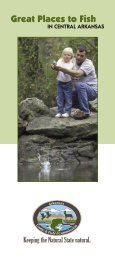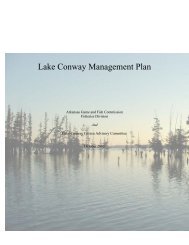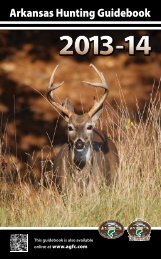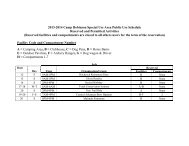Beaver Lake Tailwater | Creel Survey 1998-2000 - Arkansas Game ...
Beaver Lake Tailwater | Creel Survey 1998-2000 - Arkansas Game ...
Beaver Lake Tailwater | Creel Survey 1998-2000 - Arkansas Game ...
You also want an ePaper? Increase the reach of your titles
YUMPU automatically turns print PDFs into web optimized ePapers that Google loves.
<strong>Beaver</strong> <strong>Tailwater</strong> <strong>Creel</strong> <strong>Survey</strong> <strong>1998</strong> – <strong>2000</strong>Final ReportAGFC Trout Management ProgramReport# TP-03-03Jeffrey S. WilliamsAssistant Trout BiologistDarrell W. BowmanTrout BiologistC. Stan ToddAssistant Trout BiologistRon MooreDistrict 1 Fisheries BiologistMike BivinData Base AnalystRalph FourtRetired District 1 Fisheries BiologistMike GibsonChief of Fisheries<strong>Arkansas</strong> <strong>Game</strong> and Fish Commission#2 Natural Resources DriveLittle Rock, AR 72205-9986
Executive SummaryAnglers spent an average of 85,629 hours per year fishing the <strong>Beaver</strong> <strong>Tailwater</strong>. Annualeffort estimates declined from 106,682 hours in <strong>1998</strong> to 85,024 hours in 2001. Anglingpressure was heaviest in the upstream reaches of the tailwater. Pressure ranged from51,307 h/km directly below the dam to 2,057 h/km near the Houseman Access.Approximately 76% of all anglers interviewed on the <strong>Beaver</strong> <strong>Tailwater</strong> were residents of<strong>Arkansas</strong>. Anglers from nearby and joining states (Kansas, Missouri, Oklahoma, andTexas) made up the majority of the non-resident anglers. Only 1% of the trips wereguided trips.The percentages of anglers using artificial tackle and bait were similar at 38%. Theremaining 24% used both artificial tackle and bait while fishing the <strong>Beaver</strong> <strong>Tailwater</strong>.Most (65%) of the anglers were using spinning equipment while 28% were using flyfishing gear.An average of 241,664 trout were stocked annually below <strong>Beaver</strong> Dam. Anglers caughtan average of 136,815 trout, of which 27,515 (20%) were harvested and the remaining109,300 (80%) were released. Annual estimates of total catch and harvest declined overthe three-year survey. Catch rates on the <strong>Beaver</strong> <strong>Tailwater</strong> (1.6 trout/h) were some of thehighest observed on <strong>Arkansas</strong> tailwaters.Rainbow trout made up the majority (80%) of the fish that were stocked annually. Thisspecies also made up 79% (107,485 fish) of the total trout catch and almost all (99.8%) ofthe total trout harvest. The highest catch rate for rainbow trout was in the catch andrelease area at 1.8 trout/h.Anglers caught over 20,739 brown trout from the <strong>Beaver</strong> <strong>Tailwater</strong> annually, althoughjust 13,963 were stocked. Less than 1% of the brown trout caught by anglers wereharvested. The area just below <strong>Beaver</strong> Dam had the highest catch rate of brown trout at0.41 trout/h.Of the nearly 22,000 cutthroat trout stocked annually, anglers caught just 13% of these.Harvest of cutthroat trout was extremely low with 8 fish being harvested the first year ofthe survey and none the last two years. Catch rates for cutthroat trout were the lowestobserved among all trout species at 0.03 trout/h.Anglers caught approximately 50% of the 12,367 brook trout stocked each year. Nobrook trout were harvested during the entire survey period. Brook trout were mostcommon in the upstream reaches of the tailwater where anglers caught 0.11 trout/h.Angling effort and harvest in this survey were similar to that observed in a 1980 creelsurvey done on the <strong>Beaver</strong> <strong>Tailwater</strong>. However, stocking levels have increaseddramatically over the past two decades. In 1980, about 54,000 trout were stocked with27,800 being harvested, which equates to a harvest efficiency of 51%. A similar harvest1
Executive Summary (continued)(27,515 trout) was observed in the present study, although nearly 242,000 trout werestocked. After adjusting for fish that were protected from harvest, the current estimate ofharvest efficiency is 16%.2
Introduction<strong>Beaver</strong> Dam is located on the White River at river kilometer 980 in Carroll County,<strong>Arkansas</strong>. The dam was built by the U.S. Army Corps of Engineers for the purposes offlood control and hydroelectric power generation and was the last project to beconstructed on the White River. Commercial power generation began in May 1965,although the project was not officially completed until 1966. The resulting <strong>Beaver</strong><strong>Tailwater</strong> flows approximately 12 km (7.5 mi) through northwest <strong>Arkansas</strong> and entersTable Rock <strong>Lake</strong>. Hypolimnetic discharge from <strong>Beaver</strong> Dam created coldwater habitatthat was less suitable for native sportfish species (Bacon et al. 1968). To mitigate for theloss of the warmwater fishery, the <strong>Arkansas</strong> <strong>Game</strong> and Fish Commission began stockingtrout into the <strong>Beaver</strong> <strong>Tailwater</strong> in 1966. The species currently stocked into the <strong>Beaver</strong><strong>Tailwater</strong> are rainbow trout (Onchorynchus mykiss), brown trout (Salmo trutta), cutthroattrout (Onchorynchus clarkii), and brook trout (Salvelinus fontinalis).Discharge capacity for each of the dam’s two turbines is normally 112 cms (3,950 cfs)with a total maximum discharge through both turbines of about 257 cms (9,085 cfs).Leakage from the dam and discharge from the facility’s house generator provide a baseflow of approximately 1.8 cms (63 cfs).The trout fishery in the <strong>Beaver</strong> <strong>Tailwater</strong> is managed primarily through stocking andregulation. Regulations in place as of <strong>1998</strong> included a daily limit of 6 fish of which nomore than two of the following species may be retained; brown trout, cutthroat trout, andbrook trout. Size restrictions include a 16-inch minimum length limit for both browntrout and cutthroat trout and a 14-inch minimum length limit for brook trout. In 1995, acatch-and-release area was instituted on the <strong>Beaver</strong> <strong>Tailwater</strong>. This area extends from0.8 km (0.5 miles) below <strong>Beaver</strong> Dam to 0.09 km (100 yards) above the Parker Bend3Access for a total distance of approximately 1.9 km (1.2 miles). Fishing is restricted toartificial lures with single, barbless hooks. All fish caught within this area must bereleased immediately.Major flooding in 1990 forced the Corps of Engineers to open the floodgates on <strong>Beaver</strong>Dam for approximately ten days. The 1,416 cms (50,000 cfs) discharge severelyimpacted the area downstream of the dam. Banks were eroded, the gravel riverbed wasscoured, and aquatic vegetation was removed. This destruction of habitat negativelyimpacted the trout fishery. <strong>Survey</strong>s conducted in 1991 by the <strong>Arkansas</strong> <strong>Game</strong> and FishCommission (AGFC) revealed that the trout population had declined dramatically alongwith populations of important prey organisms. In 1994, work began on a plan to improvetrout habitat in <strong>Beaver</strong> <strong>Tailwater</strong> (Filipek 1994). The objectives of the project were tohalt bank erosion, re-establish the primary channel, and to restore instream habitat.Effective management of trout fisheries like the <strong>Beaver</strong> <strong>Tailwater</strong> requires currentinformation on angler effort and success. Estimates of fishing pressure and harvest ratesallow for determination of proper stocking levels. Information on angler characteristicscan offer managers a better understanding of the people using the resource (Malvestuto1983). Between September <strong>1998</strong> and August 2001, an intensive creel survey was3
conducted on the <strong>Beaver</strong> <strong>Tailwater</strong>. The objectives of this creel survey were to 1) obtainestimates of total angling effort 2) estimate angler success in the form of catch andharvest rates as well as total catch and harvest and 3) describe angler characteristics.MethodsThe data necessary for estimating fishing pressure was obtained through aerial countswhile information on angler success and characteristics was gained through an accesspoint creel survey. <strong>Creel</strong> clerks worked a six-hour shift approximately ten days permonth. Start times for each shift were randomly determined. Ten aerial flights werescheduled for each month of the survey. Flight start times were chosen randomly andeach flight lasted approximately two hours. A pilot and observer made counts of bank,boat, and wading anglers over the entire tailwater area. All angler counts and surveyswere conducted during daylight hours and no attempt was made to estimate nighttimeangling effort.For the purposes of this study, the <strong>Beaver</strong> <strong>Tailwater</strong> was divided into four zones (Figure1). These zones were: Zone 1, beginning 0.1 km (100 yards) below <strong>Beaver</strong> Dam andending at the upstream boundary of the catch-and-release area; Zone 2, the catch-andreleasearea; Zone 3, beginning at the downstream boundary of the catch-and-release areaand ending at the Highway 62 Bridge; and Zone 4, extending from the Highway 62Bridge to 1.6 km (1 mile) below the Houseman access area.Monthly data was grouped into seasons in the following manner: fall (September,October, November); winter (December, January, February); spring (March, April, May);and summer (June, July, August). “<strong>Creel</strong> years” did not follow calendar years, thereforedata reported for a given year is actually for September of that year through August of thefollowing year.Catch rates and harvest rates were calculated using the total ratio estimator (Malvestuto1983, Crone and Malvestuto 1991). Instantaneous counts made during the aerial flightswere expanded to estimate total fishing effort (Lambou 1961, Malvestuto 1983). Totalcatch and total harvest were calculated by multiplying effort estimates by catch andharvest rates. Seasonal and zonal differences among catch rates were tested usingMinitab Release 13 for Windows ® statistical software at an alpha level of 0.05.Results and DiscussionAngler EffortBetween September <strong>1998</strong> and August 2001, creel clerks on the <strong>Beaver</strong> <strong>Tailwater</strong>interviewed 3,325 anglers. Angling pressure counts were obtained from 326 flights.4
Anglers spent an average of 85,629 hours per year fishing the <strong>Beaver</strong> <strong>Tailwater</strong>. Annualangling effort declined from 106,682 hours (S.E. = 4,906) in <strong>1998</strong> to 85,024 hours (S.E.= 5,605) in 1999 and declined further in <strong>2000</strong> to 65,181 hours (S.E. = 4,031) (Figure 2,Table 1). These figures represent an approximately 20% decrease annually or a 39%decline overall.Historic information pertaining to angler effort and success for this fishery is relativelyscarce. Prior to the current study, only one other creel survey, performed in 1980, hadbeen done on the <strong>Beaver</strong> <strong>Tailwater</strong> (National Reservoir Research Program 1981). The1980 study was conducted for a period of nine months beginning in March 1980.Anglers spent a total of 83,900 hours fishing the <strong>Beaver</strong> <strong>Tailwater</strong> in 1980 (Table 2). It isimportant to note that the 1980 survey only covered three seasons (spring, summer, andfall) for a single year.The amount of annual angling pressure per kilometer ranged from 8,780 h/km in <strong>1998</strong> to5,365 h/km in <strong>2000</strong> (Figure 3). The mean annual fishing pressure in the present study(7,048 h/km) was similar to that observed in 1980 (6,906 hours/km). Angling pressureon the <strong>Beaver</strong> <strong>Tailwater</strong> was slightly higher than the mean pressure estimated for theGreers Ferry <strong>Tailwater</strong> (6,396 hours/km) from 1988 to 1992 (Bowman et al. 1994) (Table1). <strong>Creel</strong> surveys on other <strong>Arkansas</strong> tailwaters, however, suggest that fishing pressure onthe <strong>Beaver</strong> <strong>Tailwater</strong> is lower when compared to these fisheries. Todd et al. (1999)reported 9,097 hours/km and 23,201 hours/km on the Bull Shoals and Norfork tailwaters,respectively.The percentages of total fishing effort made up of boat and bank angling were nearlyidentical at 40% and 42%, respectively. Wading effort contributed an average of 19% tothe overall total of angler hours. The annual contribution of boat pressure declined from41% in <strong>1998</strong> to 36% in 1999, but increased to 42% in <strong>2000</strong> (Figure 4). The percentage ofbank angling pressure increased from 34% in <strong>1998</strong> to 47% in <strong>2000</strong> while the proportionof wading hours declined from 26% to 11% during this time.The contribution of boat, bank, and wade angling to total angler hours varied by zone(Figure 5). The general pattern observed was that the occurrence of bank and wadeanglers declined downstream while the percentage of boat anglers increased. Bankanglers were the predominant type in Zones 1 and 2 at 53% and 40%, respectively.Anglers fishing from boats, however, dominated the lower reaches of the <strong>Beaver</strong><strong>Tailwater</strong>. In Zone 3, 58% of the anglers fished from boats while in Zone 4 thispercentage was 88%. Wade anglers contributed the lowest percentages of total anglerhours in all zones except Zone 1 where 25% of the anglers waded.Fishing pressure varied seasonally, although no clear pattern was evident (Figure 6).<strong>Creel</strong> surveys done on other <strong>Arkansas</strong> tailwaters have shown that angling effort istypically highest in the summer months (June through August) and lowest in the winter(December through February) (Oliver 1984; Todd et al. 1999). During this study, thehighest mean seasonal angling pressure occurred in the spring (March-May) with 29,046hours, although the lowest pressure was observed in the winter (13,779 angler hours).5
Summer angling effort was highest only in <strong>1998</strong> (37,395 angler hours) and was thelowest seasonal effort observed in 1999 (8,868 angler hours).Generally, fishing pressure on the <strong>Beaver</strong> <strong>Tailwater</strong> was highest nearest the dam anddecreased downstream (Figure 7). This pattern was observed in each of the three creelyears. Mean annual effort per kilometer ranged from 51,307 h/km in Zone 1 to 2,057h/km in Zone 4. Statistical analysis indicated that differences among zones weresignificant (p
Anglers traveled an average of 85 miles (one-way) to fish the <strong>Beaver</strong> <strong>Tailwater</strong>. Almost70% of the anglers had traveled less than 50 miles. Anglers traveling over 200 milesaccounted for 11% of those interviewed while 4% of the anglers traveled more than 400miles. These results suggest that anglers traveled fewer miles to fish the <strong>Beaver</strong><strong>Tailwater</strong> compared to other <strong>Arkansas</strong> tailwaters. Todd et al. (1999) reported that anglerstraveled an average of 185 miles to fish. Approximately 32% of those anglers hadtraveled over 200 miles and 18% had traveled more than 400 miles.For the purposes of this study, bait was defined as either natural bait (e.g. night crawlers,minnows, wax worms) or processed baits (e.g. marshmallows, salmon eggs, PowerBait ® ). The definition of artificial included both lures (e.g. crankbaits, spinners, jigs) andflies. The percentage of anglers using artificial lures increased from 30% in <strong>1998</strong> to 46%in <strong>2000</strong> (Figure 12). The average annual percentage of artificial lure use was 38%. Liveand natural bait use increased from 35% in <strong>1998</strong> to 47% in 1999, but decreased to 33% inthe final year of the survey. A slight majority of anglers in Zones 1 and 3 used bait at54% and 55%, respectively (Figure 13). Zone 2, however, had most (84%) of the anglersusing artificial lures and flies. Around 16% of the anglers in Zone 2 were using bait,either alone or in combination with artificials, despite the gear restriction in this area.The highest percentage (31%) of anglers using a combination of bait and artificial lureswas observed in Zone 4.In the <strong>1998</strong> creel period, 69% of the anglers used spinning gear and 25% used fly fishinggear (Figure 14). These percentages remained relatively unchanged the following year at68% and 25%, respectively. However, in <strong>2000</strong> the percentage of anglers using fly fishingequipment had increased to 33% while the proportion of anglers fishing with spinninggear had decreased to 59%. Anglers in Zones 1, 3, and 4 were using spinning gear at74%, 76%, and 95%, respectively (Figure 15). Most (71%) of the anglers in Zone 2,however, used flyfishing gear.The percentage of anglers that fished the catch-and-release area increased from 18% in<strong>1998</strong> to 29% in <strong>2000</strong> (Figure 16). Only 1% (N=46) of the total trips (N = 3,261) wereguided.Angler SuccessBetween September <strong>1998</strong> and August 2001, almost 725,000 trout weighing 102,195 kg(225,302 lbs.) were stocked into the <strong>Beaver</strong> <strong>Tailwater</strong>. During this same period, a total of82,545 trout were harvested with an additional 327,901 trout being caught and released(Figure 17). This equates to an overall harvest efficiency of 11%, which is substantiallylower than the 51% harvest efficiency reported from the 1980-81 <strong>Beaver</strong> creel survey(Table 2). Harvest efficiency is defined as the number of trout harvested divided by thenumber of trout stocked. After adjusting harvest efficiency for trout that are protectedfrom harvest by special regulations, the estimate increased slightly to 16%. The numberof trout caught and released increased from 119,863 to 135,527 between <strong>1998</strong> and 1999,but decreased to 72,511 trout in <strong>2000</strong>.7
Annual harvest estimates were 26,857 trout (5,992 kg) and 16,180 trout (3,446 kg) for the1999 and <strong>2000</strong> sample periods, respectively. These figures represent a decline in harvestfrom <strong>1998</strong> when 39,778 trout (9,631 kg) were harvested. Harvest rates for zones outsideof the catch and release area decreased only slightly from 0.38 trout/h in <strong>1998</strong> to 0.33trout/h in <strong>2000</strong>. The rate at which anglers harvested fish ranged from 0.28 trout/h inZone 4 to 0.40 trout/h in Zone 3. The decline in harvest between <strong>1998</strong> and 1999 cannotbe attributed to angling pressure because despite a drop in total angler hours, there wasslight increase (2%) in the total number of trout caught. In <strong>2000</strong>, however, reducedangling effort was accompanied by lower catch and harvest rates.In the first year of the survey, anglers on the <strong>Beaver</strong> <strong>Tailwater</strong> caught 159,641 trout. Thisnumber increased to 162,114 trout being caught the following year. In <strong>2000</strong>, however,the total number of trout caught by anglers dropped to 88,691 fish, a 45% decrease from1999. Catch rates ranged from 1.4 trout/h in <strong>2000</strong> to 1.9 trout/h in 1999 and averaged 1.6trout/h for the entire survey period. The catch rate of almost two trout per hour in 1999allowed for a greater overall catch even though effort was lower.Compared to other <strong>Arkansas</strong> tailwaters, catch rates on the <strong>Beaver</strong> <strong>Tailwater</strong> wererelatively high. Catch rates for the Bull Shoals and Norfork <strong>Tailwater</strong>s were found torange between 0.81 trout/h and 0.97 trout/h during a 1995-<strong>1998</strong> creel survey (Todd et al.1999). Earlier surveys on these two tailwaters reported catch rates of 0.75 trout/h in1970-71 and 0.55 trout/h in 1980-81 (Oliver 1984). Anglers caught an average of 0.81trout/h on the Greers Ferry <strong>Tailwater</strong> (Bowman et al. 1994).The mean catch rate for all trout species combined was higher in the catch-and-releasearea (2.06 trout/h) than all other zones (Figure 18). Zone 1 had the second highest catchrate at 1.78 trout/h. The lowest catch rate for trout came from Zone 4 (0.53 trout/h). Thehighest catch rate for trout larger than 406mm (16in) was also observed in the catch-andreleasearea (0.021 trout/h). Zone 4 had the next highest catch rate for trout larger than406mm (16in) at 0.010 trout/h as compared to Zones 1 and 3 (0.003 and 0.004 trout/h,respectively).Mean seasonal catch rates were generally highest in the winter and fall at 1.56 trout/h and1.47 trout/h, respectively (Figure 19). The lowest seasonal catch rate was observed in thesummer (0.946 trout/h). Spring catch rates were highly variable ranging from almost twotrout per hour in 1999 to just under one trout per hour in <strong>2000</strong>.Rainbow TroutDuring the three-year survey period, 580,531 rainbow trout (96,046 kg) were stocked intothe <strong>Beaver</strong> <strong>Tailwater</strong> (Figure 20). Of these, 82,362 (14%) were harvested by anglers withan additional 41% being caught and released. These figures together account for only55% of the rainbow trout stocked during this period. The annual harvest of rainbow troutdeclined from 39,656 trout (S.E. = 3,281 trout) in <strong>1998</strong> to only 16,168 trout (S.E. = 1,923trout) in <strong>2000</strong>. Because rainbow trout made up almost all of the total annual harvest8
(Mean = 99.8%), the decrease in total annual trout harvest mirrored the decline inrainbow trout harvest.The annual catch rate of rainbow trout increased significantly from 1.2 trout/h (S.E. = 0.3trout/h) in <strong>1998</strong> to 1.5 trout/h (S.E. = 0.3 trout/h) in 1999 (p=0.007). The following yearthe catch rate of rainbow trout decreased to 1.1 trout/h (S.E. = 0.4 trout/h), but thisdecline was not significant (p=0.315). Catch rates over the three-year period averaged1.3 trout/h.Catch rates of rainbow trout varied among zones with all zones being significantlydifferent from each other (p
highest mean catch rate at 0.41 brown trout/h. The catch rates in Zone 2 (0.15 trout/h)and Zone 3 (0.07 trout/h) were similar, but were significantly different from the other twozones. Although anglers caught more brown trout per hour in Zone 1, the catch rate ofbrown trout 406 mm (16in) or larger was slightly higher in the catch- and- release zone at0.003 trout/h.Spring catch rates of brown trout were the highest (0.20 trout/h), followed by winter(0.19 trout/h) and fall (0.14 trout/h). There was no significant difference, however,among these three seasons. The lowest seasonal catch rate was observed in summerwhen anglers caught 0.11 trout per hour. There was a significant difference between thespring and summer estimates (p=0.017).The total catch of brown trout from the <strong>Beaver</strong> <strong>Tailwater</strong> was comprised almost entirely(91%) of fish 300mm (12in) or less. The annual catch rate of these stocked size fishincreased from 0.18 trout/h in <strong>1998</strong> to 0.31 trout/h in 1999 then decreased to 0.16 trout/hin <strong>2000</strong>. The catch rate of 300-406mm (12-16in) trout remained constant the first twoyears of the survey at 0.027 trout/h but declined in <strong>2000</strong> to 0.010 trout/h.Almost all (99.7%) of the brown trout caught during the creel survey were released.Brown trout in the 407-508mm (16-20in) size range were harvested at a higher rate(29%) than fish in the >508mm (> 20in) group in which no fish were harvested. With thestatewide regulations on brown trout, 406mm (16in) minimum length limit and dailylimit of two), the low harvest on fish smaller than 406mm (16in) is not surprising.However, some illegal harvest of trout less than 300mm (12in) did occur the first twoyears of the survey.Cutthroat TroutDuring the three-year survey period, 65,472 cutthroat trout (2,982 kg) were stocked intothe <strong>Beaver</strong> <strong>Tailwater</strong> (Figure 22). Of these, 13 % (8,188 trout) were caught and releasedby anglers. Only 8 cutthroat trout were harvested during this study, which equates to aharvest efficiency of less than 1%.The annual catch rate of cutthroat trout also increased the second year of the survey from0.026 trout/h (S.E. = 0.01 trout/h) in <strong>1998</strong> to 0.052 trout/h (S.E. = 0.03 trout/h) in 1999.The catch rate of cutthroat trout in the final year decreased to 0.015 trout/h (S.E. = 0.009trout/h).The highest catch rate of cutthroat trout was in Zone 1 (0.040 trout/h), although this wasnot significantly different from Zone 2 (0.032 trout/h) (p=0.639). Anglers in Zone 3caught 0.022 cutthroat trout per hour, which was similar to the catch rate observed inZone 2 (p=0.072) and Zone 4 (0.008 trout/h) (p=0.648). The catch-and-release area hadthe highest catch rate of cutthroat trout larger than 406mm (16in) at 0.0007 trout/h.Despite this higher rate, only 36 cutthroat trout larger than 406mm (16in) were caughtduring the entire three-year period.10
Winter catch rates of cutthroat trout were the highest at 0.06 trout/h, followed by spring(0.03 trout/h) and fall (0.03 trout/h). There was no significant difference, however,among these three seasons. Summer anglers caught the fewest cutthroat trout (0.02trout/h), which was significantly lower than winter. The <strong>Beaver</strong> <strong>Tailwater</strong> is stockedwith cutthroat trout from late winter through early spring and this probably accounts forthe high catch rates during this time.Cutthroat trout less than 300mm (12 in) in length made up 81% of all those caught. Theannual percentage increased from 68% in <strong>1998</strong> to 83% in <strong>2000</strong>. Conversely, thepercentage of cutthroats caught that were between 300mm (12in) and 406mm (16in)decreased from 32 % in <strong>1998</strong> to 17% in <strong>2000</strong>. Less than 1% of the total cutthroat catchincluded trout over 406mm (16 in).Brook TroutNo brook trout were harvested between September <strong>1998</strong> and August 2001 although morethan 37,000 brook trout (1,176 kg) were stocked. In the <strong>1998</strong> creel period, 10,084 brooktrout (S.E = 2,415 trout) were caught and released. This figure declined to 5,568 brooktrout (S.E = 1,374 trout) in 1999 and again to only 1,926 brook trout (S.E = 656 trout) in<strong>2000</strong> (Figure 23).Annual catch rates for brook trout declined steadily from a high of 0.095 trout/h (S.E. =0.058 trout/h) in <strong>1998</strong> to 0.030 trout/h (S.E. = 0.020 trout/h) in <strong>2000</strong>. Despite thisdecline, catch rates for brook trout were consistently higher than those observed forcutthroat trout.Catch rates for brook trout were higher in Zone 1 (0.11 trout/h) than all other areas(p
Other SpeciesPaddlefishPaddlefish (Polyodon spathula) are native to the White River although damming andother habitat alterations limited their distribution to the lower reaches (Robison andBuchanan 1988). The Missouri Department of Conservation has reestablished apopulation of paddlefish in Table Rock <strong>Lake</strong>. In some years, sexually mature adults werethought to move upstream into the <strong>Beaver</strong> <strong>Tailwater</strong> and congregate below the dam.Reclassification of paddlefish as a sport fish in 1989, restricted snagging for this speciesto within 0.09 km (100 yards) below dams statewide. Angling of any kind below <strong>Beaver</strong>Dam, however, is prohibited in the first 0.09 km below the dam for safety reasons. Thisrestriction precluded any snagging opportunities for paddlefish below <strong>Beaver</strong> Dam.Pressure from anglers caused the AGFC to open the area between the “No FishingBeyond This Point” sign and the concrete boat ramp approximately 0.18 km (200 yards)downstream of the dam to snagging. Snagging is permitted from April 15 to June 15with a daily creel limit of two paddlefish. Anglers must cease snagging once half thedaily limit of trout is taken. In 1991 and <strong>1998</strong>, access point creel surveys were conductedon the <strong>Beaver</strong> tailwater during the snagging season in order to determine snagging effortand harvest for paddlefish, trout, and other species.In 1991, estimated snagging effort on the <strong>Beaver</strong> <strong>Tailwater</strong> was 467 hours, whichaccounted for 14% of the total angling pressure within the area where snagging waspermitted (Fielder 1991). Snagging effort dropped 48% in <strong>1998</strong> to 242 hours (5% of totalangling pressure) (Fielder and Fourt 1999). During the 1991 study, approximately 128paddlefish were snagged and harvested by anglers. The report for the <strong>1998</strong> snaggingstudy indicates that no paddlefish, or trout, were snagged by anglers. Results of the<strong>1998</strong>-<strong>2000</strong> creel survey indicated that anglers on the <strong>Beaver</strong> <strong>Tailwater</strong> caught anestimated 33 paddlefish. These paddlefish were taken in the spring of the first creel yearfrom Zone 4 and all were released. No paddlefish were caught the second or third yearsof the creel survey. Although paddlefish did not contribute a significantly to the totalfishery during the <strong>1998</strong>-2001 creel survey, this may not always be the case. Paddlefishtend to be more abundant in the <strong>Beaver</strong> <strong>Tailwater</strong> when spring water levels are high. Theextremely low water levels observed during Spring 1999 and reduced discharge in Spring<strong>2000</strong> may have resulted in decreased numbers of paddlefish. Paddlefish are likely tocontribute a greater portion to the <strong>Beaver</strong> <strong>Tailwater</strong> fishery in years when spring waterlevels are above normal.WalleyeWalleye (Stizostedion vitreum) are considered native to <strong>Arkansas</strong> only in the northernportion of the White River drainage (Robison and Buchanan 1988). Impoundment of theupper White River destroyed much of walleye’s original habitat although populationscontinue to survive in most of the reservoirs. During the spawning months (March12
through April) adult walleye migrate upstream. AGFC regulations for walleye on the<strong>Beaver</strong> <strong>Tailwater</strong> include a 457mm (18in) minimum length limit and a daily limit of four.These regulations mirror those imposed by the Missouri Department of Conservation forthe walleye fishery in Table Rock <strong>Lake</strong>.During the three-year creel period, anglers on the <strong>Beaver</strong> <strong>Tailwater</strong> caught 69 walleye.Most (80%) of these fish were caught in the area downstream of the Highway 62 Bridge.Estimated catch increased from 8 walleye in <strong>1998</strong> and 1999 to 53 fish in the last year ofthe survey. None of the 8 walleye caught in <strong>1998</strong> were harvested. All of these fish werebetween 407mm (16 in) and 508mm (20 in) although it is not known how many, if any,were larger than the 457mm (18in) length limit. Anglers harvested all of the walleyecaught the following year (all of these fish were 508mm (20in) or longer). In <strong>2000</strong>, theentire catch of walleye in Zone 1 consisted of fish smaller than 300mm (12in) and all ofthese fish were released. The harvest of walleye in <strong>2000</strong> consisted of 22 fish between407mm (16in) and 508mm (20in) and 17 fish larger than 508mm (20in), all of whichwere caught in Zone4.Illegal HarvestIn 1997, concerns over illegal harvest of trout in the <strong>Beaver</strong> <strong>Tailwater</strong> catch-and-releasearea were addressed to AGFC enforcement personnel. An increase in enforcementefforts coincided with this creel survey. In 1999, an estimated 7,352 trout were harvestedillegally from the catch-and-release area (Figure 24). This figure is based on the 1999calendar year instead of the creel period to allow for comparison with enforcement data.An estimate for illegal harvest in <strong>1998</strong> is unavailable because only the fall season wassampled for that year. However, it is assumed that the level of illegal harvest in <strong>1998</strong>was similar to or slightly higher than 1999. AGFC enforcement officers issued 43citations to anglers in the catch and release section of <strong>Beaver</strong> <strong>Tailwater</strong> in 1999 (CaptainLuther Hungate personal communication). This was a 59% increase from the number ofcitations issued the previous year (27 citations). The following year illegal harvest in thecatch-and-release area dropped to 1,136 trout and the number of citations issueddecreased to 20. In <strong>2000</strong>, no illegal harvest was observed in the catch-and-release area.It is important to note here that the citations issued include all Code 31.16 violations inthe catch and release section and are not limited strictly to illegal harvest. However, theincreased presence of enforcement officers in the area is likely to have deterred allviolators.It should be noted here that the reduction in illegal harvest could be attributed to a changein creel clerks during the study and the manner in which they dealt with violations. Forthe first half of the survey, the creel clerk counted illegally harvested fish as part of anangler’s total harvest. During the second part of the study, the new creel clerk did notinclude illegal fish in harvest counts. This would have resulted in a decrease in illegallyharvested fish as measured by the creel survey. The patterns observed in citations issued,however, suggest that AGFC enforcement activity did play a significant role in thedecline in illegal harvest.13
Stocking LevelsStocking levels during this survey were higher than those observed in previous years(Figure 25). In 1980, approximately 54,000 trout were stocked in the <strong>Beaver</strong> <strong>Tailwater</strong>(AGFC unpublished data). Stocking rates increased slightly in the mid to late 1980’s, butgenerally ranged between 60,000 and 80,000 trout. Beginning in the early 1990’s,however, stocking levels increased to over 100,000 trout annually and exceeded 150,000trout in 1995 and 1996. From 1997 to present the number of trout stocked below <strong>Beaver</strong>Dam has increased even further and now exceeds 200,000 annually. Stocking levels havegrown in an attempt to match a perceived increase in the angling effort this tailwaterreceives. Unfortunately, there is no clear evidence that angler effort has increased.Pender and Kwak (2002) found that natural reproduction in the <strong>Beaver</strong> <strong>Tailwater</strong> waslow. Therefore, stocking is necessary to maintain the trout fishery in this system.Researchers have found, however, that the <strong>Beaver</strong> <strong>Tailwater</strong> is a less productive systemwhen compared to other <strong>Arkansas</strong> tailwaters (Brown et al. 1967; Pender and Kwak2002). Current stocking levels may exceed the level that the <strong>Beaver</strong> <strong>Tailwater</strong> cansupport. The paucity of larger trout in the angler catch suggests that the growth of troutin the <strong>Beaver</strong> <strong>Tailwater</strong> may be limited by food availability. Weiland and Hayward(1997) found that increased stocking rates along with food base degradation led to adecrease in the number of large rainbow trout in <strong>Lake</strong> Taneycomo, Missouri and theMissouri Department of Conservation has since reduced the number of trout stockedthere.Seasonal stocking levels are set by the AGFC to match angling effort. Fewer trout arestocked during periods of low angling pressure and more trout are stocked as anglingeffort increases. This study suggests that seasonal stocking levels for the <strong>Beaver</strong><strong>Tailwater</strong> are well matched to seasonal patterns in angler effort and no changes toseasonal stocking patterns are recommended at this time (Figure 26).Management RecommendationsIn a general summary, the <strong>Beaver</strong> <strong>Tailwater</strong> seems to be a providing an excellent troutfishery in terms of high angler catch rates, but not for large trout even in the catch-andreleasearea. Biological information is needed to determine why and to help withmanagement decisions. Specifically, data is needed that identifies rates of growth,mortality, and exploitation by species. Although many studies have been conducted onthe <strong>Beaver</strong> <strong>Tailwater</strong> over time, these basic aspects of population dynamics are notknown for this fishery.Compared to the 1981 <strong>Beaver</strong> <strong>Tailwater</strong> creel survey, angler effort, trout harvested, andtrout harvest rate have not changed appreciably, yet annual rainbow trout stockingnumbers have increased from 54,000 to 241,000, which is an increase of 445%. Thisexplains why rainbow trout harvest efficiency has fallen from 51% in 1981 to 11% (16%14
after adjusting for fish protected from harvest) at present. Plus, we are now also stockingadded numbers of other species of trout that were not stocked during the prior creelsurvey.It is also important to note that trout harvest rate and numbers harvested declined steadilyover this three-year survey. The perception by non-trained fisheries managers might bethat more fish stocked with the same number harvested would mean more fish aresurviving longer and growing to larger sizes in this fishery. Given that very few trout ofany species are being caught larger than “stocked” size, this does not seem to be the case,even in the catch-and-release area. Therefore, either growth rates are depressed orsurvival is low (mortality high) or some combination exists. This is why we need thecomplimentary biological data discussed in paragraph one of this section.Our current management philosophy is to provide rainbow trout for put-n-take troutangling and provide brown, brook, and cutthroat trout for more diversity and a “trophy”component to the fishery. The Catch-and-Release area was created to provide quality ortrophy size rainbow trout which are otherwise un-protected by special regulations. Theangling community seems to be changing and therefore we need new and currentinformation regarding angler satisfaction and desires to make informed managementdecisions and to evaluate the applicability of current management philosophy.The following lists specific management recommendations based on the results of thissurvey:1) Conduct complimentary bio-surveys to include investigations ofspecies size structure, relative abundance, and growth andmortality rates.2) Gather current information on trout angler satisfaction anddesires associated with this fishery.3) Develop a <strong>Beaver</strong> <strong>Tailwater</strong> management plan that addresses thefollowing:• Redirect some angling pressure from Zone 1 to Zones 3 and4 by improving habitat and bank access.• Decrease number of rainbow trout stocked.• Review brook and cutthroat trout management.• Research needs.• Put-n-Take vs. Quality trout management.15
Literature CitedBacon, E. J., Jr., S. H. Newton, R. V. Kilambi, and C. E. Hoffman. 1968. Changes in theicthyofauna in the <strong>Beaver</strong> Reservoir tailwaters. Proceedings of the 32 nd AnnualConference of Southeastern Association of <strong>Game</strong> and Fish Commissioners 32:245-248.Bowman, D. W., T. R. Bly, S. P. Filipek, C. A. Perrin, J. D. Stark, and B. K. Wagner.1994. Angler use, success, and characteristics on Greers Ferry <strong>Tailwater</strong>, <strong>Arkansas</strong>,with implications to management. Proc. Annnu. Conf. Southeast Assn. Fish andWildl. Agencies 48:499-511.Brown, J. D., C. R. Liston, and R. W. Dennie. 1967. Some physio-chemical andbiological aspects of three cold tailwaters in northern <strong>Arkansas</strong>. Proceedings of the31 st Annual Conference of Southeastern Association of <strong>Game</strong> and FishCommissioners 369 -381.Crone, P. R. and S. P. Malvestuto. 1991. Comparison of five estimates of fishingsuccess from creel survey data on three Alabama reservoirs. Pages 61-66 in D.Guthrie, J. M. Hoenig, M. Holiday, C. M. Jones, M. J. Mills, S. A. Moberly, K. H.Pollock, and D. R. Talhelm, eds. <strong>Creel</strong> and angler surveys in fisheries management.American Fisheries Society, Bethesda, Maryland.Fielder, C. 1991. Evaluation of a special two-month snagging season. AGFC Report.Fielder, C. and R. A. Fourt. 1999. Effects of a two-month paddlefish snagging season ontrout angling. AGFC Report.Filipek, S. P. 1994. <strong>Beaver</strong> tailwater restoration and habitat improvement project.AGFC Report.Lambou, V. W. 1961. Determination of fishing pressure from fishermen or party countswith a discussion of sampling problems. Proceedings of the Annual ConferenceSoutheastern Association of <strong>Game</strong> and Fish Commissioners 15:380-401.Malvestuto, S. P. 1983. Sampling the recreational creel. Pages 591-623 in B. R.Murphy and D. W. Willis, eds. Fisheries Techniques second edition. AmericanFisheries Society, Bethesda, Maryland.National Reservoir Research Program. 1981. <strong>Beaver</strong> reservoir sport fish harvest andangler use. U. S. Fish and Wildlife Service Report.Oliver, M. L. 1984. The rainbow trout fishery in Bull Shoals-Norfork <strong>Tailwater</strong>s,<strong>Arkansas</strong>, 1971-81. Proc. Annnu. Conf. Southeast Assn. Fish and Wildl. Agencies38:549-561.16
Pender, D. R. and T. J. Kwak. 2002. Factors influencing brown trout reproductivesuccess in Ozark tailwater rivers. Transactions of the American Fisheries Society131:698-717.Rider, L. L., M. Hudy, and C. McLemore. 1988. 1988 <strong>Arkansas</strong> trout fishing survey.AGFC Report.Robison, H. W. and T. M. Buchanan. 1988. The fishes of <strong>Arkansas</strong>. The University of<strong>Arkansas</strong> Press, Fayetteville.Todd, C. S., J. D. Stark, and W. M. Bivin. 1999. Bull Shoals-Norfork <strong>Tailwater</strong> creel1995-<strong>1998</strong>. AGFC Report.Weiland, M. A. and R. S. Hayward. 1997. Cause for the decline of large rainbow troutin a tailwater fishery: too much putting or too much taking? Transactions of theAmerican Fisheries Society 126:758-773.17
Figure 1. Map showing the <strong>Beaver</strong> <strong>Tailwater</strong>, <strong>Arkansas</strong> and the four zones used in the <strong>1998</strong>-2001 creel survey.
Figure 2. Total estimated fishing effort observed on the <strong>Beaver</strong> <strong>Tailwater</strong> during a threeyearcreel survey (<strong>1998</strong>-<strong>2000</strong>).1<strong>2000</strong>0106682Total Angler Hours100000800006000040000<strong>2000</strong>08502465181856290<strong>1998</strong> 1999 <strong>2000</strong> Mean<strong>Creel</strong> <strong>Survey</strong> YearFigure 3. Estimated fishing pressure per mile observed on the <strong>Beaver</strong> <strong>Tailwater</strong> during athree-year creel survey (<strong>1998</strong>-<strong>2000</strong>).16,00014,13014,00012,00011,26111,34110,0008,6338,0006,0004,0002,0000<strong>1998</strong> 1999 <strong>2000</strong> Mean<strong>Creel</strong> <strong>Survey</strong> Year
Figure 4. Contribution of various angling methods to total angling effort during a threeyearcreel survey on the <strong>Beaver</strong> <strong>Tailwater</strong> (<strong>1998</strong>-<strong>2000</strong>).Percent of Total Hours50454035302520151050<strong>1998</strong> 1999 <strong>2000</strong> Mean<strong>Creel</strong> <strong>Survey</strong> YearBoatBankWadeFigure 5. Percentage of various angler types by zone on the <strong>Beaver</strong> <strong>Tailwater</strong> during athree-year creel survey (<strong>1998</strong>-<strong>2000</strong>).Percent of Total Hours10090807060504030201001 2 3 4ZoneBoatBankWade20
Figure 6. Seasonal angling effort during a three-year creel survey on the <strong>Beaver</strong><strong>Tailwater</strong> (<strong>1998</strong>-<strong>2000</strong>).Angler Hours40000350003000025000<strong>2000</strong>0150001000050000Fall Winter Spring SummerSeason<strong>1998</strong>1999<strong>2000</strong>MeanFigure 7. Angler effort per mile in survey zones of the <strong>Beaver</strong> <strong>Tailwater</strong> observed duringa three-year creel survey (<strong>1998</strong>-<strong>2000</strong>).100,00090,00080,000Angler Hours per Mile70,00060,00050,00040,00030,00020,00010,000<strong>1998</strong>1999<strong>2000</strong>Mean01 2 3 4Zone21
Figure 8. Total angling effort per zone on the <strong>Beaver</strong> <strong>Tailwater</strong> observed during a threeyearcreel survey (<strong>1998</strong>-<strong>2000</strong>).Angler Hours4500040000350003000025000<strong>2000</strong>01500010000500001 2 3 4Zone<strong>1998</strong>1999<strong>2000</strong>MeanFigure 9. Seasonal pool elevation of Table Rock <strong>Lake</strong> below <strong>Beaver</strong> <strong>Tailwater</strong>, <strong>Arkansas</strong>during the three-year creel survey and four- years prior to the study. Note: The fouryear average includes elevation levels from the four years prior to the survey, 1994through 1997.Mean 1994-1997 <strong>1998</strong> 1999 <strong>2000</strong>Pool Elevation (ft-msl)918916914912910908906904902900898896Fall Winter Spring SummerSeason22
Figure 10. Seasonal discharge from <strong>Beaver</strong> Dam during two year of the <strong>Beaver</strong> creelsurvey and four years prior to the study. Note: The four year average includesdischarge levels from the four years prior to the survey, 1994 through 1997.3000Mean 1994-1997 <strong>1998</strong> 1999<strong>Beaver</strong> Dam Discharge (dsf)2500<strong>2000</strong>150010005000Fall Winter Spring SummerSeasonFigure 11. Origin of non-resident anglers visiting the <strong>Beaver</strong> <strong>Tailwater</strong> from September<strong>1998</strong> to August 2001. Note: only those states representing more than one percent ofall resident anglers are shown.Percent of Anglers Interviewed454035302520151050IL IA KS LA MN MS MO OK TN TXState of Residence23
Figure 12. Percent use of artificial lures and bait on the <strong>Beaver</strong> <strong>Tailwater</strong>, <strong>Arkansas</strong> from<strong>1998</strong> to <strong>2000</strong>. The definition of bait included natural bait (e.g. night crawlers,minnows, wax worms) as well as processed baits (e.g. marshmallows, salmon eggs,Power Bait ® ).Percent Use (%)50454035302520151050<strong>1998</strong> 1999 <strong>2000</strong> Mean<strong>Creel</strong> <strong>Survey</strong> YearArtificialBaitBothFigure 13. Percent use of artificial lures and bait by zone on the <strong>Beaver</strong> <strong>Tailwater</strong>,<strong>Arkansas</strong> from <strong>1998</strong> to <strong>2000</strong>. The definition of bait included natural bait (e.g. nightcrawlers, minnows, wax worms) as well as processed baits (e.g. marshmallows,salmon eggs, Power Bait ® ).9080Percent Use (%)7060504030201001 2 3 4ZoneArtificialBaitBoth24
Figure 14. Percent use of various gear types used by anglers on the <strong>Beaver</strong> <strong>Tailwater</strong>,<strong>Arkansas</strong> from <strong>1998</strong> to <strong>2000</strong>.8070Percent Use (%)605040302010SpinningFlyCombinedOther0<strong>1998</strong> 1999 <strong>2000</strong> Mean<strong>Creel</strong> <strong>Survey</strong> YearFigure 15. Percent use of various gear types by zone on the <strong>Beaver</strong> <strong>Tailwater</strong>, <strong>Arkansas</strong>from <strong>1998</strong> to <strong>2000</strong>.Percent Use (%)10090807060504030201001 2 3 4ZoneSpinningFlyCombinedOther25
Figure 16. Percentage of anglers fishing the catch-and-release area on the <strong>Beaver</strong><strong>Tailwater</strong> during a three-year creel survey (<strong>1998</strong>-<strong>2000</strong>).35Percentage of Anglers (%)302520151050<strong>1998</strong> 1999 <strong>2000</strong> Mean<strong>Creel</strong> <strong>Survey</strong> YearFigure 17. Number of trout harvested and released annually during the <strong>Beaver</strong> <strong>Tailwater</strong>creel survey (<strong>1998</strong>-<strong>2000</strong>).180000160000140000Number of Trout1<strong>2000</strong>010000080000600004000011986313552772511ReleasedHarvested<strong>2000</strong>00397782658716180<strong>1998</strong> 1999 <strong>2000</strong><strong>Creel</strong> <strong>Survey</strong> Year26
Figure 18. Catch rates for all trout species combined by zone on the <strong>Beaver</strong> <strong>Tailwater</strong>,<strong>Arkansas</strong> from <strong>1998</strong> to <strong>2000</strong>.2.5Catch Rate (trout/hour)21.510.5<strong>1998</strong>1999<strong>2000</strong>Mean01 2 3 4ZoneFigure 19. Catch rates by season on the <strong>Beaver</strong> <strong>Tailwater</strong>, <strong>Arkansas</strong> from <strong>1998</strong> to <strong>2000</strong>.Catch Rate (trout/hour)2.01.81.61.41.21.00.80.60.40.20.0Fall Winter Spring SummerSeason<strong>1998</strong>1999<strong>2000</strong>Mean27
Figure 20. Stocking, catch, and harvest levels of rainbow trout on the <strong>Beaver</strong> <strong>Tailwater</strong>,<strong>Arkansas</strong> during a three-year creel survey (<strong>1998</strong>-<strong>2000</strong>).250000<strong>2000</strong>00Number of Trout15000010000050000StockedCaughtHarvested0<strong>1998</strong> 1999 <strong>2000</strong> Mean<strong>Creel</strong> <strong>Survey</strong> YearFigure 21. Stocking, catch, and harvest levels of brown trout on the <strong>Beaver</strong> <strong>Tailwater</strong>,<strong>Arkansas</strong> during a three-year creel survey (<strong>1998</strong>-<strong>2000</strong>).3500030000Number of Trout25000<strong>2000</strong>01500010000StockedCaughtHarvested50000114 49 12 58<strong>1998</strong> 1999 <strong>2000</strong> Mean<strong>Creel</strong> <strong>Survey</strong> Year28
Figure 22. Stocking, catch, and harvest levels of cutthroat trout on the <strong>Beaver</strong> <strong>Tailwater</strong>,<strong>Arkansas</strong> during a three-year creel survey (<strong>1998</strong>-<strong>2000</strong>).3500030000Number of Trout25000<strong>2000</strong>01500010000StockedCaughtHarvested500008 0 0 3<strong>1998</strong> 1999 <strong>2000</strong> Mean<strong>Creel</strong> <strong>Survey</strong> YearFigure 23. Stocking and catch levels of brook trout on the <strong>Beaver</strong> <strong>Tailwater</strong>, <strong>Arkansas</strong>from a three-year creel survey (<strong>1998</strong>-<strong>2000</strong>). Note: no brook trout were harvestedduring the entire survey period.Number of Trout<strong>2000</strong>01800016000140001<strong>2000</strong>10000800060004000<strong>2000</strong>0<strong>1998</strong> 1999 <strong>2000</strong> Mean<strong>Creel</strong> <strong>Survey</strong> YearStockedCaught29
Figure 24. Illegal harvest and citations issued in the <strong>Beaver</strong> <strong>Tailwater</strong> catch and releasezone from <strong>1998</strong> to 2001).5080Citations Issued4540353025201510570605040302010Trout Harvested x 100CitationsHarvest00<strong>1998</strong> 1999 <strong>2000</strong> 2001YearFigure 25. Total number of trout stocked into the <strong>Beaver</strong> <strong>Tailwater</strong> between 1980 and2001. Data for some years could not be verified and were not included.300Number of Trout Stocked x 1,0002502001501005001980 1982 1984 1986 1988 1990 1992 1994 1996 <strong>1998</strong> <strong>2000</strong>Year30
Figure 26. Seasonal stocking and angling effort on the <strong>Beaver</strong> <strong>Tailwater</strong>, <strong>Arkansas</strong>during a three-year creel survey (<strong>1998</strong>-<strong>2000</strong>). Note: the number of trout stocked andthe number of angler hours are on the same scale.Rainbows StockedAngler Hours800007000060000500004000030000<strong>2000</strong>0100000FA'98WI'99SP'99SU'99FA'99WI'00SP'00SU'00FA'00WI'01SP'01SU'01Season
Table 1. Comparison of angler effort and success for between the <strong>Beaver</strong> <strong>Tailwater</strong> and other <strong>Arkansas</strong> tailwater trout fisheries.Estimate<strong>Beaver</strong>(<strong>1998</strong>-<strong>2000</strong>)Bull Shoals(1980-1981)Bull Shoals(1995-<strong>1998</strong>)Greers Ferry(1988-1992)Norfork(1980-1981)Norfork(1995-<strong>1998</strong>)Angler hours 85,629 1,241,552 1,309,899 295,319 104,200 176,327Angler hours/km 7,048 7,845 9,097 6,396 14,472 23,201Total stocked (N) 241,664 769,237 1,130,529 276,921 44,139 102,967Total stocked (kg) 75,101 128,060 248,263 49,206 8,463 17,640Total caught (N) 136,815 - - 215,509 - -Total harvested (N) 27,515 677,198 428,640 160,440 57,722 28,644Total harvested (kg) 6,356 151,104 146,284 39,786 17,428 11,705Harvest Efficiency (%) 16* 88 67 58 - 30Harvest rate (N/hr) 0.35** 0.55 0.31 0.55 0.55 0.19Catch rate (N/hr) 1.59 - - 0.73 - -*This harvest efficiency value is adjusted for fish that are protected from harvest.**Harvest rate for areas other than the catch and release area.
Table 2. Estimates of angler effort and success from a one-year creel survey conducted in 1980 and a three-year creel surveyconducted from <strong>1998</strong>-<strong>2000</strong> on the <strong>Beaver</strong> <strong>Tailwater</strong>, <strong>Arkansas</strong>. All four trout species are included in harvest and catch values.Note: Harvest rate and harvest efficiency for the <strong>1998</strong>-2001 survey are adjusted for fish that were protected from harvest.Variable 1980* <strong>1998</strong> 1999 <strong>2000</strong>Mean(<strong>1998</strong>-<strong>2000</strong>)Angler hours 83,900 106,682 85,024 65,181 85,629Angler hours/km 6,905 8,780 6,998 5,365 7,048Total N stocked 54,000 235,225 240,022 249,746 241,664Total N harvested 27,800 39,778 26,587 16,180 27,515Total N caught - 159,641 162,114 88,691 136,815Total kg stocked - 73,539 73,899 77,864 75,101Total kg harvested - 9,631 5,992 3,446 6,356Harvest Effeciency (%) 51 24 17 8 16Harvest rate (trout/h) 0.33 0.38 0.36 0.33 0.35Catch rate (trout/h) - 1.50 1.91 1.36 1.59* Note: The 1980 survey was conducted for just three seasons (Spring, Summer, Fall) while the <strong>1998</strong>-<strong>2000</strong> study included allfour seasons of each year.33


